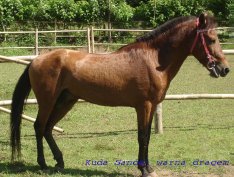Horses of Onekawa-Nukanoa: Difference between revisions
No edit summary |
No edit summary |
||
| Line 1: | Line 1: | ||
[[File:Noniusz_mezohegyes.jpg|thumb|px200|A | [[File:Noniusz_mezohegyes.jpg|thumb|px200|A Whakatōpū stallion]] | ||
The history of the horse in [[Onekawa-Nukanoa|Ngati Onekawa-Nukanoa]] is recorded as far back the 4th century, with the current population of horses estimated to be 470,000 and an additonal 8,500 feral horses that roam under the monitoring and management of the [[Association of Malaio-Ozeros Nations]]. Horses have played a key role in Onekawan agriculture, culture and history since their introduction, but since the turn of the 20th century they have mostly be kept solely for recreational and sporting purposes. | The history of the horse in [[Onekawa-Nukanoa|Ngati Onekawa-Nukanoa]] is recorded as far back the 4th century, with the current population of horses estimated to be 470,000 and an additonal 8,500 feral horses that roam under the monitoring and management of the [[Association of Malaio-Ozeros Nations]]. Horses have played a key role in Onekawan agriculture, culture and history since their introduction, but since the turn of the 20th century they have mostly be kept solely for recreational and sporting purposes. | ||
Revision as of 02:27, 29 August 2021
The history of the horse in Ngati Onekawa-Nukanoa is recorded as far back the 4th century, with the current population of horses estimated to be 470,000 and an additonal 8,500 feral horses that roam under the monitoring and management of the Association of Malaio-Ozeros Nations. Horses have played a key role in Onekawan agriculture, culture and history since their introduction, but since the turn of the 20th century they have mostly be kept solely for recreational and sporting purposes.
History and Breeds
A handful of remains of horses have been identified in an proto-Onekawan hunting pit and a singular cave site, but the extreme rarity of these finds indicates that these animals were likely to have been "castaways" from shipwrecks or natural means and left no lasting impression on the narive ecosystem. Zebras from Zanzali are the exception to equines in Ngati Onekawa-Nuknoa, very occasionally crossing the (INSERT SWAMP DELTA) in small groups, often in times of severe drought. Onekawans hunted these animals during the pre-Tahamajan period, but these ebcounters were rare.
The horse was first properly introduced by Tahamajan traders in the mid-to-late 9th century as a mount, beast-of-burden and trade good. These endemic pulaui horses were small, rarely exceeding 12h in height and came in a variety of colours and confirmations. These first horses proved popular and their usage spready rapidly throughout the late 9th and early 10th centuries once their value in agriculture and war was realized.
These horses helped to facilitate the Onekawan "Agriculutral Revolution" alongside the introduction of rice and Template:Diprotodon. Whilst Onekawans had been using the Template:Moa as livestock and beast-of-burden, and proved superior in forested and hilly terrain that made up most of Onekawa at the time, Horses (and Bunyips) filled new transport niches from their feathered counterparts that dramatically increased the level and efficiency of trade between Onekawan communities. The speed at which they could travel on roads and flatter terrain alongside the increase in their load carry capacity helped to extend the connections of villages ever further afield spurring increased economic development.
Whilst horses initally came from pulaui stock, the growing Tahamajan trade network and demand for horses quickly saw the introduction of of horses from Ochran and Scipia. The expansion of the Bayarid Empire in Ochran concurrent with the increasing dominance of the Tahamaja Empire in the Ozeros had significant influence in early history of Onekawan horses. Known for their endurance and toughness, bayarid steppe horses proved very popular, particularly amongst Template:Hapu who resided in roughre terrain, where there Kaiahuwhenua prised the animals in the rearing and management of their Moa flocks.


